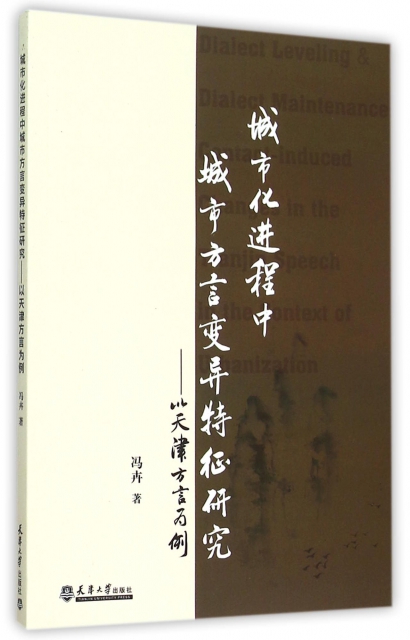| | | | 城市化進程中城市方言變異特征研究--以天津方言為例(英文版) | | 該商品所屬分類:外語 -> 口語/生活實用英語 | | 【市場價】 | 219-316元 | | 【優惠價】 | 137-198元 | | 【介質】 | book | | 【ISBN】 | 9787561853580 | | 【折扣說明】 | 一次購物滿999元台幣免運費+贈品
一次購物滿2000元台幣95折+免運費+贈品
一次購物滿3000元台幣92折+免運費+贈品
一次購物滿4000元台幣88折+免運費+贈品
| | 【本期贈品】 | ①優質無紡布環保袋,做工棒!②品牌簽字筆 ③品牌手帕紙巾
|
|
| 版本 | 正版全新電子版PDF檔 | | 您已选择: | 正版全新 | 溫馨提示:如果有多種選項,請先選擇再點擊加入購物車。*. 電子圖書價格是0.69折,例如了得網價格是100元,電子書pdf的價格則是69元。
*. 購買電子書不支持貨到付款,購買時選擇atm或者超商、PayPal付款。付款後1-24小時內通過郵件傳輸給您。
*. 如果收到的電子書不滿意,可以聯絡我們退款。謝謝。 | | | |
| | 內容介紹 | |

-
出版社:天津大學
-
ISBN:9787561853580
-
作者:馮卉
-
頁數:176
-
出版日期:2015-12-01
-
印刷日期:2015-12-01
-
包裝:平裝
-
開本:16開
-
版次:1
-
印次:1
-
字數:337千字
-
馮卉所著的《城市化進程中城市方言變異特征研
究--以天津方言為例(英文版)》以前期在國企和外企
所作的有關天津話變異的試驗性研究為基礎,提出可
能會影響天津話變異趨勢的分析模式,即在城市化進
程中,普通民眾對方言感知以及使用的態度變化、地
域及職業的流動性所引發的個體的社會網絡變化、政
府對推廣普通話力度的加強,這三方面的力量在每個
個體方言的使用過程中不停地在抗衡。標準語言市場
和語言思想是推進語言標準化的“向心力”,在它的
作用下,方言中的地方特色會逐漸消失;與此相反,
傾向於地方文化的地方語言市場和語言思想則是“離
心力”,在它的作用下,方言中的地方特色被保留在
個體的話語中。正是這兩種無形力量的制約與抗衡最
終決定方言的特征是逐漸消失還是被保留。在此分析
模式的基礎上,本研究對141名土生土長的天津人所
使用的天津方言的變異與變化進行了分析和闡釋。為
此,在考察傳統的四個社會因素(年齡、性別、職業
和教育程度)對語言學變量的影響之外,我們同時找
出另外六個可能會對天津話的變異產生影響的社會心
理因素,即受訪者的工作地點性質、工作時間長短、
對天津話的態度、在工作中及工作環境以外的社會網
絡密度以及在工作中普通話使用的情況。
-
Chapter 1 Introduction
1.1 Dialect Contact Studies: An Emergent Field of Enquiry
1.2 Globalization and the Changing Tianfin Dialect
1.3 Layout of the Book
Chapter 2 Language Variation and Change: From Traditional Dialectology to Social Dialectology
2.1 The Western Tradition in the Study of Language Variation and Change
2.1.1 Historical Linguistic Studies: Achievements and Limitations
2.1.2 Sociolinguistie Perspectives
2.1.2.1 Variationist Approach
2.1.2.2 Social Network Theory
2.1.3 Dialect Contact
2.1.3.1 Language Contact versus Dialect Contact
2.1.3.2 Traditional Dialeetology versus Social Dialeetology
2.1.3.3 Theory and Principles for Dialect Contact
2.1.3.4 Processes/Mechanisms of Dialect Contact
2.2 The Study of Language Variation and Change in the Chinese Context
2.2.1 Philological Studies
2.2.2 Sociolinguistic Studies
2.2.3 Studies on Tianjin Dialect
2.2.3.1 Salient Features of Tianfin Dialect
2.2.3.2 Sociolinguistic Studies on Tiajin Dialect
2.2.4 Dialect Contact Research
2.2.4.1 Deficiencies of Traditional Chinese Dialectology
2.2.4.2 Dialect Contact--An Emergent Field of Inquiry in China
2.2.4.3 Limitations of Previous Sociolinguistic Researches on Tianjin Dialect
Chapter 3 The Proposed Framework
3.1 Pilot Study
3.2 The Framework
3.2.1 Language Ideology
3.2.2 Linguistic Market
3.3 Dialect Leveling
3.3.1 Standard Linguistic Market
3.3.2 Loose-knit Social Network
3.3.3 Process of Long-term Accommodation
3.4 Dialect Maintenance
3.4.1 Globalization and Local Culture
3.4.2 Close-knit Social Network
3.4.3 Vernacular Linguistic Market
3.5 Summary
Chapter 4 Variables and Data Collection
4.1 Social Variables
4.1.1 Demographic Variables
4.1.1.1 Sex
4.1.1.2 Age
4.1.1.3 Occupation
4.1.1.4 Level of Education
4.1.1.5 Workplace
4.1.1.6 Length of Service
4.1.2 Sociopsychologieal Variables
4.1.2.1 Attitude towards Tianfin Dialect
4.1.2.2 Frequency of Contact with Putonghua
4.1.2.3 Frequency of Using Putonghua at Work
4.2 Linguistic Variables
4.2.1 Lexical Items
4.2.2 Consonants
4.2.3 Application of FF Rule
4.3 Data Collection
4.3.1 Observer's Paradox
4.3.2 Selecting Informants
4.3.3 Collecting Data for Consonants and FF Rule
4.3.4 Collecting Data for Lexieal Items
Chapter 5 Data Analysis, Findings and Discussion
5.1 Construction of the Lexieal Items
5.2 Relations between AGE/SEX/OCC/EDU and Linguistic Variables
5.2.1 AGE with Linguistic Variables
5.2.2 EDU with Linguistic Variables
5.2.3 SEX with Linguistic Variables
5.2.4 OCC with Linguistic Variables
5.2.5 MODEL-1 with Four Demographic Variables
5.3 Relations between WP/LoS and Linguistic Variables
5.3.1 WP with Residuals of Linguistic Variables
5.3.2 LoS with Residuals of Linguistic Variables
5.3.3 MODEL-2 with Six Demographic Variables
5.4 Relations between ATT/SOCNET1/SOCNET2/FREQ and Linguistic Variables
5.4.1 Relations between ATT and Linguistic Variables
5.4.2 Relations between SOCNET1/SOCNET2 and Linguistic Variables
5.4.3 Construction of SOCNET
5.4.4 Relations between FREQ and Linguistic Variables
5.4.5 MODEL-3 with Sociopsychological Variables
5.5 Effect of WP on ATT, SOCNET1 and FREQ
5.6 MODEL-4 with All Significant Variables
5.7 Linguistic Variations in Different Styles
5.8 The Group of Informants with the Most Features of Tianjin Dialect
5.9 Change in Progress?
5.9.1 Lexical Change in Progress
5.9.2 Peculiar Consonant Change in Progress
5.9.3 FF Rule Change in Progress
5.10 Summary
Chapter 6 Conclusion
6.1 The Changing Tianfin Dialect in the Context of Globalization
6.2 New Issues and New Directions for Research on Dialects in Contact
Appendix 1: Questionnaire
Appendix 2: Lexical Items (161 Words)
Appendix 3: The Salient Lexical Items (100 Words)
Appendix 4: Passage Reading
Appendix 5: Models with and without the Retired Informants
References
Acknowledgements
| | |
| | | | |
|




